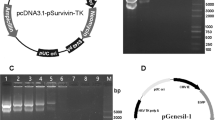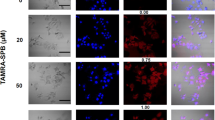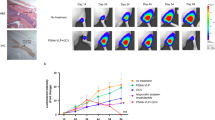Abstract
This study demonstrates in vivo effectiveness of a nonviral vector system, Epstein–Barr virus (EBV)-based plasmid vector coupled with polyamidoamine (PAMAM) dendrimer (EBV/polyplex), in suicide gene therapy of cancer. The EBV-based vector is a plasmid vector containing EBV nuclear antigen 1 (EBNA1) gene and oriP from EBV genome. HSV-1 tk gene was transferred into Ewing's sarcoma cell lines, A4573 and KP-EWS-YI, by using an EBV-based plasmid vector, pSES.Tk, or a conventional plasmid vector, pS.Tk. Cells transfected with pSES.Tk/dendrimer showed approximately 100 times lower ID50 to ganciclovir (GCV) compared with those transfected with pS.Tk/dendrimer. Intratumoral injection of pSES.Tk/dendrimer but not pS.Tk/dendrimer drastically suppressed the growth of tumors which had generated from A4573 or Huh7 hepatocellular carcinoma (HCC) cells inoculated into severe combined immunodeficiency (SCID) mice. The treatment with pSES.Tk/dendrimer also resulted in significant prolongation of survival of the mice implanted with A4573. These results suggest that the EBV/polyplex system could be useful for in vivo suicide gene therapy of cancer.
This is a preview of subscription content, access via your institution
Access options
Subscribe to this journal
Receive 12 print issues and online access
$259.00 per year
only $21.58 per issue
Buy this article
- Purchase on Springer Link
- Instant access to full article PDF
Prices may be subject to local taxes which are calculated during checkout






Similar content being viewed by others
References
Felgner PL, Ringold GM . Cationic liposome-mediated transfection Nature (Lond) 1989 373: 387–388
Tang MX, Redemann CT, Szoka FC . In vitro gene delivery by degraded polyamidoamine dendrimers Bioconjugate Chem 1996 7: 703–714
Kukowska-Latallo JF et al. Efficient transfer of genetic material into mammalian cells using starburst polyamidoamine dendrimers Proc Natl Acad Sci USA 1996 93: 4897–4902
Satoh E et al. Efficient gene transduction by Epstein–Barr virus-based vectors coupled with cationic liposome and HVJ-liposome Biochem Biophys Res Commun 1997 238: 795–799
Hirai H et al. Use of EBV-based vector/HVJ-liposome complex vector for targeted gene therapy of EBV-associated neoplasms Biochem Biophys Res Commun 1997 241: 112–118
Harada Y et al. Highly efficient suicide gene expression in hepatocellular carcinoma cells by Epstein–Barr virus-based plasmid vectors combined with polyamidoamine dendrimer Cancer Gene Ther (in press)
Yates JL, Warren N, Sugden B . Stable replication of plasmids derived from Epstein–Barr virus in various mammalian cells Nature (Lond) 1985 313: 812
Mazda O, Satoh E, Yasutomi K, Imanishi J . Extremely efficient gene transduction into lympho-hematopoietic cell lines by Epstein–Barr virus-based vectors J Immunol Meth 1997 204: 143–151
Satoh E et al. Successful transfer of ADA gene in vitro into human peripheral blood CD34+ cells by transfecting EBV-based episomal vectors FEBS Lett 1998 441: 39–42
Atzpodien J et al. Ewing's sarcoma: ex vivo sensitivity towards natural and lymphokine-activated killing Oncology 1988 45: 437–443
Sommadossi JP et al. Clinical pharmacokinetics of ganciclovir in patients with normal and impaired renal function Rev Infect Dis 1988 10 (Suppl 3): S507–S514
Izuquierdo M et al. Human malignant brain tumor response to herpes simplex thymidine kinase (HSVtk)/ganciclovir gene therapy Gene Therapy 1996 3: 491–495
Ram Z et al. Therapy of malignant brain tumors by intratumoral implantation of retroviral vector-producing cells Nature Med 1997 3: 1354–1361
Klatzmann D et al. Study group on gene therapy of metastatic melanoma. A phase I/II dose-escalation study of herpes simplex virus type 1 thymidine kinase ‘suicide’ gene therapy for metastatic melanoma Hum Gene Ther 1998 9: 2585–2594
Sterman DH et al. Adenovirus-mediated herpes simplex virus thymidine kinase/ganciclovir gene therapy in patients with localized malignancy: results of a phase I clinical trial in malignant mesothelioma Hum Gene Ther 1998 9: 1083–1092
Judde JD, Spangler G, Magrath I, Bhatia K . Use of Epstein–Barr virus nuclear antigen-1 in targeted therapy of EBV-associated neoplasia Hum Gene Ther 1996 7: 647–653
Evans TJ, Brooks L, Farrell PJ . A strategy for specific targeting of therapeutic agents to tumor cells of virus-associated cancers Gene Therapy 1997 4: 264–267
Kenny S, Ge J-Q, Westphal EM, Olsen J . Gene therapy strategies for treating Epstein–Barr virus-associated lymphomas: comparison of two different Epstein–Barr virus-based vectors Hum Gene Ther 1998 9: 1131–1141
Tomalia DA, Durst HD . Supramolecular chemistry I-directed synthesis and molecular recognition Topics Curr Chem 1993 165: 193
Singh P et al. Starburst dendrimers: enhanced performance and flexibility for immunoassays Clin Chem 1994 40: 1845–1849
Bielinska AU et al. Regulation of in vitro gene expression using antisense oligonucleotides or antisense expression plasmids transfected using starburst PAMAM dendrimers Nucleic Acids Res 1996 54: 2176–2182
Qin L et al. Efficient transfer of genes into murine cardiac grafts by starburst polyamidoamine dendrimers Hum Gene Ther 1998 9: 553–560
Freeman S et al. The ‘bystander effect’: tumor regression when a fraction of the tumor mass is genetically modified Cancer Res 1993 53: 5274–5283
Pope IM, Poston GJ, Kinsella AR . The role of bystander effect in suicide gene therapy Eur J Cancer 1997 33: 1005–1016
Sirac-Dilber M, Edvard-Smith CI . Suicide genes and bystander killing: local and distant effects Gene Therapy 1997 4: 273–274
Acknowledgements
We thank F Hoffmann-La Roche Ltd (Basel, Switzerland) for kindly providing us with GCV. We also thank Ms Satoko Watanabe (Department of Microbiology, Kyoto Prefectural University of Medicine) for her excellent secretarial assistance. This research was supported by a grant-in-aid for scientific research from the Ministry of Education, Science, Sports and Culture, Japan, and the Japan Heart Foundation and IBM Japan Research Grant.
Author information
Authors and Affiliations
Rights and permissions
About this article
Cite this article
Maruyama-Tabata, H., Harada, Y., Matsumura, T. et al. Effective suicide gene therapy in vivo by EBV-based plasmid vector coupled with polyamidoamine dendrimer. Gene Ther 7, 53–60 (2000). https://doi.org/10.1038/sj.gt.3301044
Received:
Accepted:
Published:
Issue Date:
DOI: https://doi.org/10.1038/sj.gt.3301044
Keywords
This article is cited by
-
An efficient, non-viral dendritic vector for gene delivery in tissue engineering
Gene Therapy (2017)
-
Apoptotic Induction with Bifunctional E.coli Cytosine Deaminase-Uracil Phosphoribosyltransferase Mediated Suicide Gene Therapy is Synergized by Curcumin Treatment In vitro
Molecular Biotechnology (2008)
-
Easy stable transfection of a human cancer cell line by electrogene transfer with an Epstein–Barr virus-based plasmid vector
Medical Molecular Morphology (2007)
-
Design and development of polymers for gene delivery
Nature Reviews Drug Discovery (2005)
-
Nonviral genetic transfer of Fas ligand induced significant growth suppression and apoptotic tumor cell death in prostate cancer in vivo
Gene Therapy (2003)



